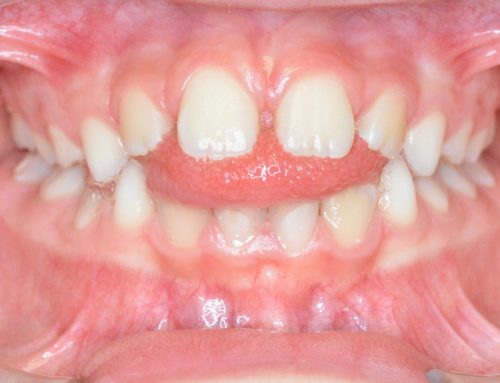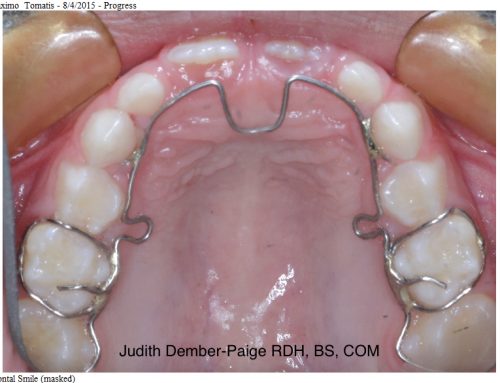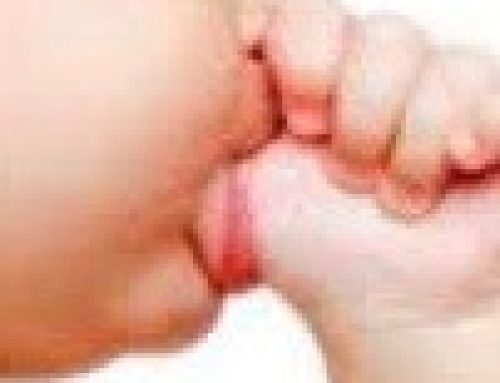By: Judith Dember-Paige RDH COM
All tongue-tie revisions need to have Orofacial Myofunctional Therapy to help establish tongue-to-palate form, lip seal, with nasal breathing. Tongue tie release therapy should take place 2 weeks to a month before the actual procedure to help build tone and better tongue rest, to help the surgery be more successful, and the tongue to have better function.
After release of the tether, the tongue does not automatically pop-up to the palate, it has to be neuromuscularly retrained for new function. When the tongue is taught to stay flat against the palate it may remodel the palate to a new broader shape. This new shape is preferred over the old high vaulted shape. As the tongue begins to flatten and broaden the palate, it makes new open spaces for the sinus cavities, and a better airway for breathing.
It is best to have tethered oral tissues released in the formative years, as a child is growing. The bones are softer and are able to be remodel with the new function. OMT is key in developing new function for the muscles.
Tethered Oral Tissues which also includes the upper lip are usually visible at birth. From the moment a baby is born and cries out for the first time, it is possible to see into their mouth and assess the status of their tongue. For the upper lip it is necessary to manually lift it up to take a look. As a baby cries it is easy to recognize if the tongue reaches high into the palatal region or if it is low with the inability to raise up. A tongue anchored to the floor of the mouth may present a problem trying to latch during breast feeding. Many times the tongue-tie status goes unnoticed if the professional delivering the baby is not train to recognize this condition. A tongue does not have to be heart shaped to be tethered, but a tether tongue may mean a lifetime of compromised health. Have the tongue revised if possible at birth, if not at birth, ASAP.
To learn more, purchase: SOS 4 TOTS – Exposing the myth about breast feeding and healing, making breastfeeding a joy. Lawrence A. Kotlow, DDS or www.kiddsteeth.com .
As in the book, “Tongue-Tie” by Alison K. Hazelbaker PhD, IBCLC, tongue-tie can be inherited. Gene mutation may be responsible, environmental factors may be implicated. The tongue plays a significant role in assisting palate and facial development starting from infancy. It is very important for the tongue to be positioned snug in the palate to assist with the forward growth necessary for proper facial development. If the tongue is tethered to the floor of the mouth, it will be limited in its expression to aid in advanced mid-face maturity.
The question has been raised. Why is it that we are seeing many more incidences of tethered oral tissues? Is it on the rise, or is it that we have become more keenly aware and are able to recognize the problems associated with the tongue anchored to the floor of the mouth?
“Tuerk and Lubit (1959) remind us, as do Horton and Crawford et al. (1969), that bone is plastic and yields to pressure, abnormal swallowing contributes to jaw malformations and facial deformities, and that tongue-tie causes improper development of the swallow, which leads to open bite and prognathism of the mandible. Whitman and Rankow (1961) claim that abnormal anatomy, such as tongue-tie, influences tongue function, which in turn influences tooth position.”
Furer (2008) Makes one of the most adamant statements about the role of the tongue in orofacial morphofunction: “The tongue is a powerful tool. It drains the ears, nose and sinuses. It scrubs the palate and the tonsils [during normal] movement. It shapes the skull bones, the palate, the nostrils and the respiratory tract, and it is the main factor responsible for the activity of the digestive system and the quality of the digestive process.”
Airway: Tongue placement during infant feeding plays a key role in airway protection for the rest of a person’s life. Correct tongue placement develops proper muscular habits for the swallow. Where the tongue goes during the swallow determines what happens to the alignment of the bony structures as the baby develops into an adult. Muscle always wins out over bone in morphogenesis.
“Although more research needs to be done to confirm this hypothesis, infancy still appears to be the ideal time to treat tongue-tie or tethered oral tissue. Early treatment may prevent the development of problems later in life.” Alison K. Hazelbaker’s book.




